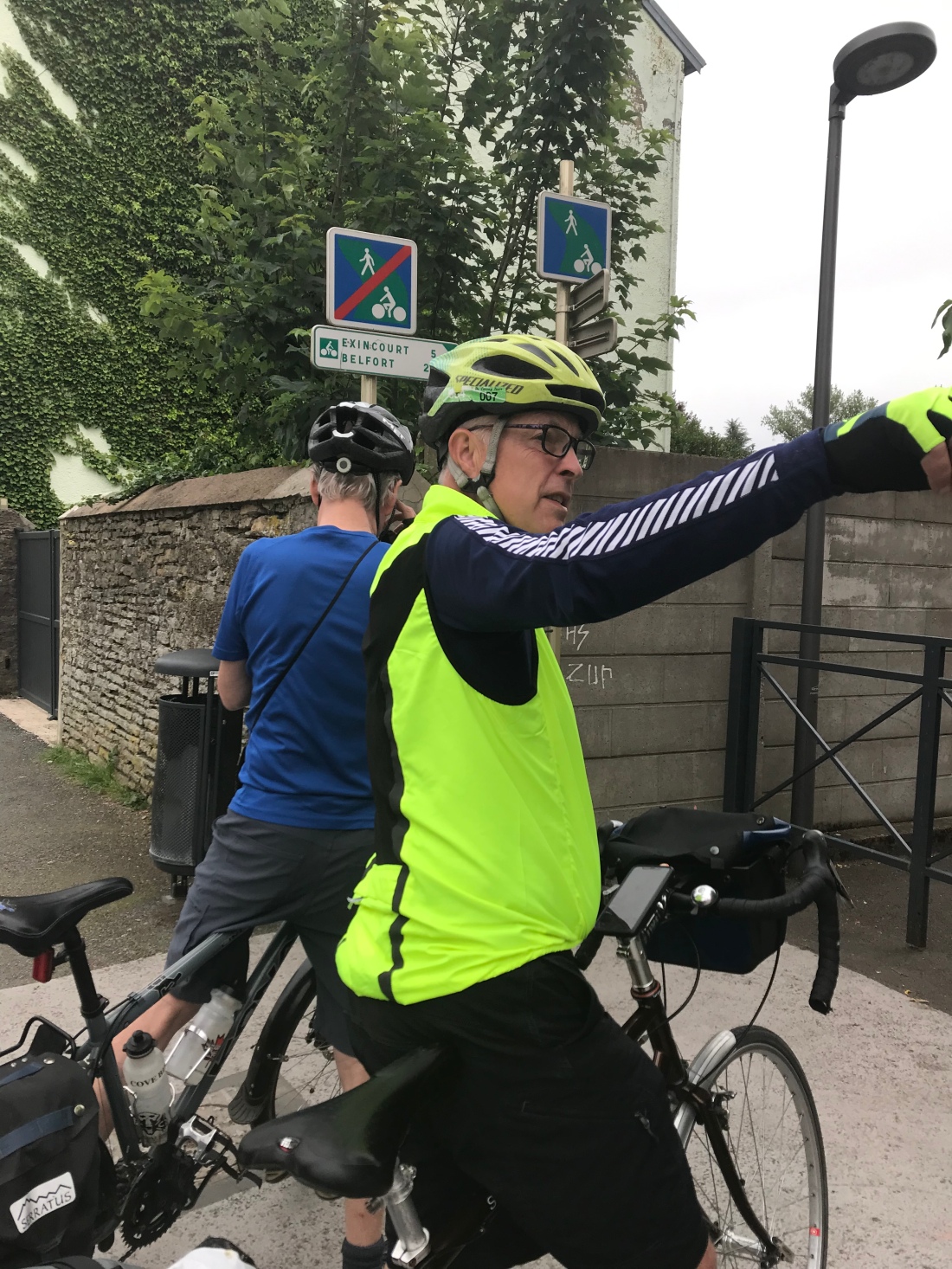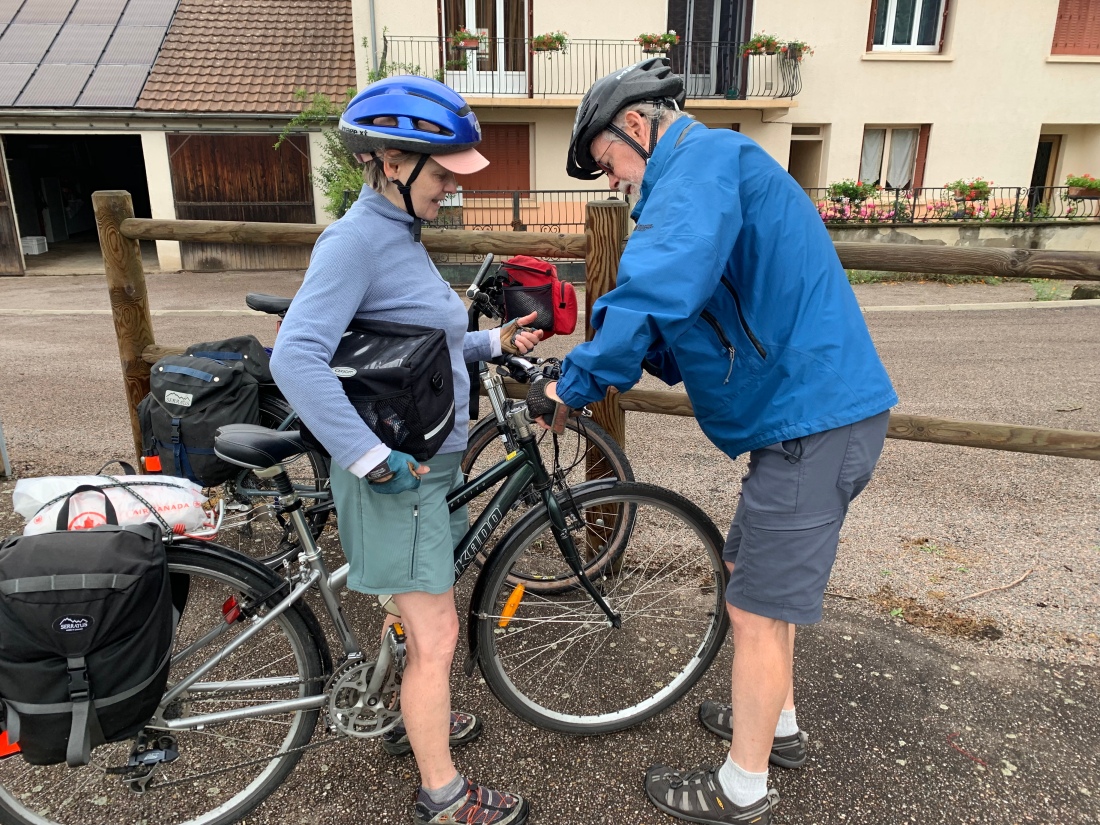
Day 14 (a.k.a. Équipe Downhill’s Ultimate Day of cycling together) dawns with blue skies, and predictions for warm temperatures; a perfect day for cycling. We do a bit of desultory foraging at La Madeleine‘s breakfast buffet: an extra yoghurt for later; an orange; a couple of bits of baguette; but our hearts aren’t really in it. There’s some sadness in the air—as you’d expect when friends part after 14 days of living in close quarters, cycling together along shaded canals and rivers, exploring village squares and churches, picnicking, dodging rain showers, and discussing life. Sharing pastries for two weeks straight is just a sweeter version of breaking bread together, and we seem to take a few more group selfies throughout the morning, perhaps to help hold on to all the wonderful memories we’ve made.
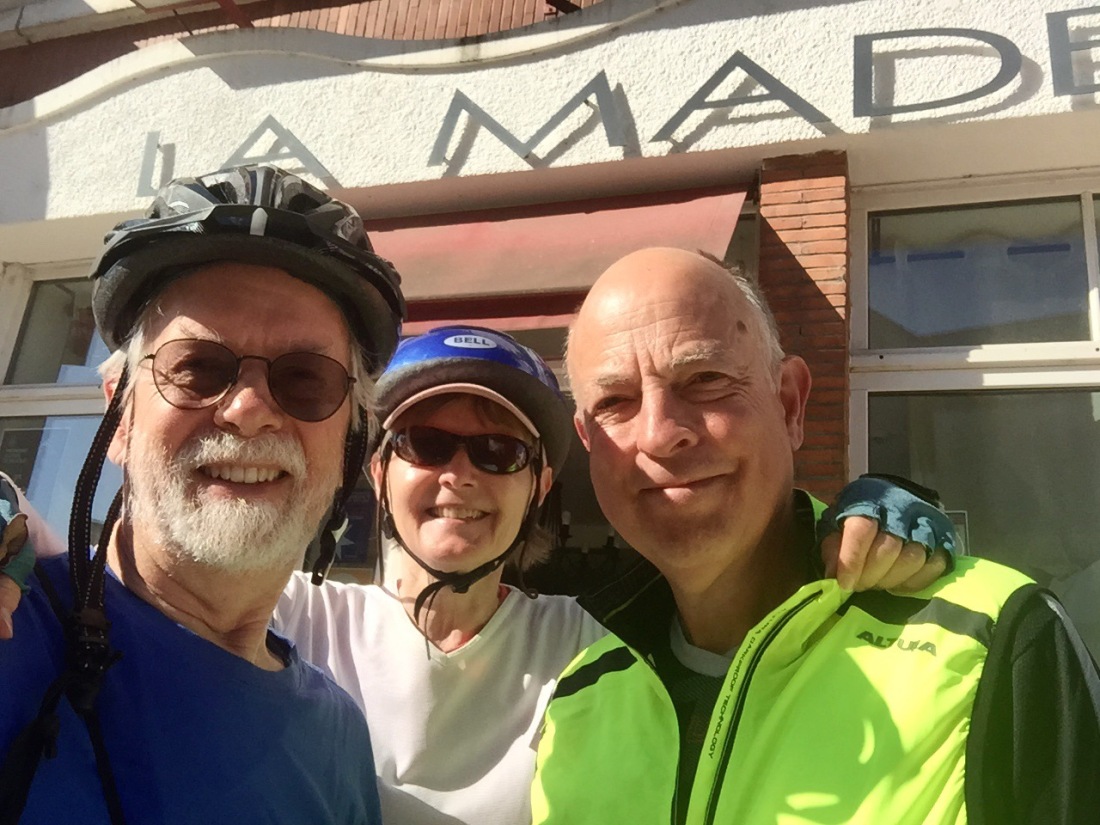
It’s been an amazing trip: all the way from Switzerland under our own power (we describe it thus to distinguish ourselves from those who ride electric bicycles—for whom we have a lot of respect, too, I hasten to add). Even having skipped a short bit by train on Day 2, we will have pedaled more than 700 km by the end of Day 14 (743 km for those who prefer precision). As A phrases it while we’re trying to put this into perspective: that’s like cycling from Vancouver to Prince George, or Stratford to Montreal, or Nice to Rome.

From Saint-Benoit-sur-Loire we continue west along the Loire towards Châteauneuf-sur-Loire, where we plan to have our final Équipe Downhill Official Pastry Tasting. As with much of Day 13, the cycle path is along the top of the levees, which guard against seasons of heavy rain. We’ve occasionally seen high-water marks engraved on the sides of buildings located near the river, so we know the risk is real, even though the Loire seems quite tranquil now.

Just before Châteauneuf-sur-Loire, J announces that we’ve cracked the 700 km barrier, which seems a good excuse for another group selfie.
In Châteauneuf-sur-Loire we find an excellent patisserie (excellent patisseries seem to be the rule rather than the exception in France), one which claims to make all of their pastries in-house. We join the queue, and salivate while considering: Pavé Castelneuvien or Charlotte Framboise? Sabatier, or another Paris Brest? One pastry? Or might two be better?
By the time we reach the register we’ve decided: two pastries seem appropriate for this special occasion; our selections: a Millefeuille Nature (with the optional green glazing) and a Trois Fruits Rouges. These are documented, divided, and eaten with our coffees at a nearby café, A sporting a rose in his bicycle helmet for the occasion. Meanwhile, across the street, bells sound a melancholy funeral toll, and mourners watch as a flag-draped coffin is carried solemnly from the local church. Memento mori.
Friday happens to be market day in Châteauneuf-sur-Loire, and the merchants have set up their stands around, and beneath, the town’s old (circa 1903) roofed market shelter. We walk our velos carefully through the aisles, admiring the things we don’t have space to carry (though J does make one purchase from a crazed—or is he merely leering?—day-vendor: an extensible magnetic device for picking up boules: a birthday gift for M).
Châteauneuf-sur-Loire is the first bridge over the Loire west of Saint-Benoit-sur-Loire, so it’s the first opportunity for J & I to veer off the Eurovelo 6 route to head towards La Ferté-Saint-Aubin. After crossing the bridge (which is undergoing maintenance work) we finally reach the point of parting: another group selfie, a round of hugs, and before you know it we’re each pedaling off on our respective ways.
A’s route will take him into Orléans (hopefully via a proper cycle path); J & I will pick our way cross-country, using a combination of GPS, maps.me, and a photographed section of Michelin map. The terrain is mostly flat, and forested; we picnic at a crossroads in the forest, about 12 km from our destination.
In La Ferté we select some bio wine, and (why not!) some pastries for our hosts: D, and the lovely L (who introduces us to her menagerie of escargots). Later, we are joined by E, who is returning from a conference on Ursula Le Guin and the Anthropocene, held in Paris (“Héritages d’Ursula Le Guin : Science, fiction et éthique pour l’Anthropocène”).
And this is where we’ll end Day 14—and our adventures on the Eurovelo 6; all’s well that ends well.
The members of Équipe Downhill thank you for your kind attention; we hope that you’ve enjoyed the ride.
Next stop for us is Paris. A bientôt!































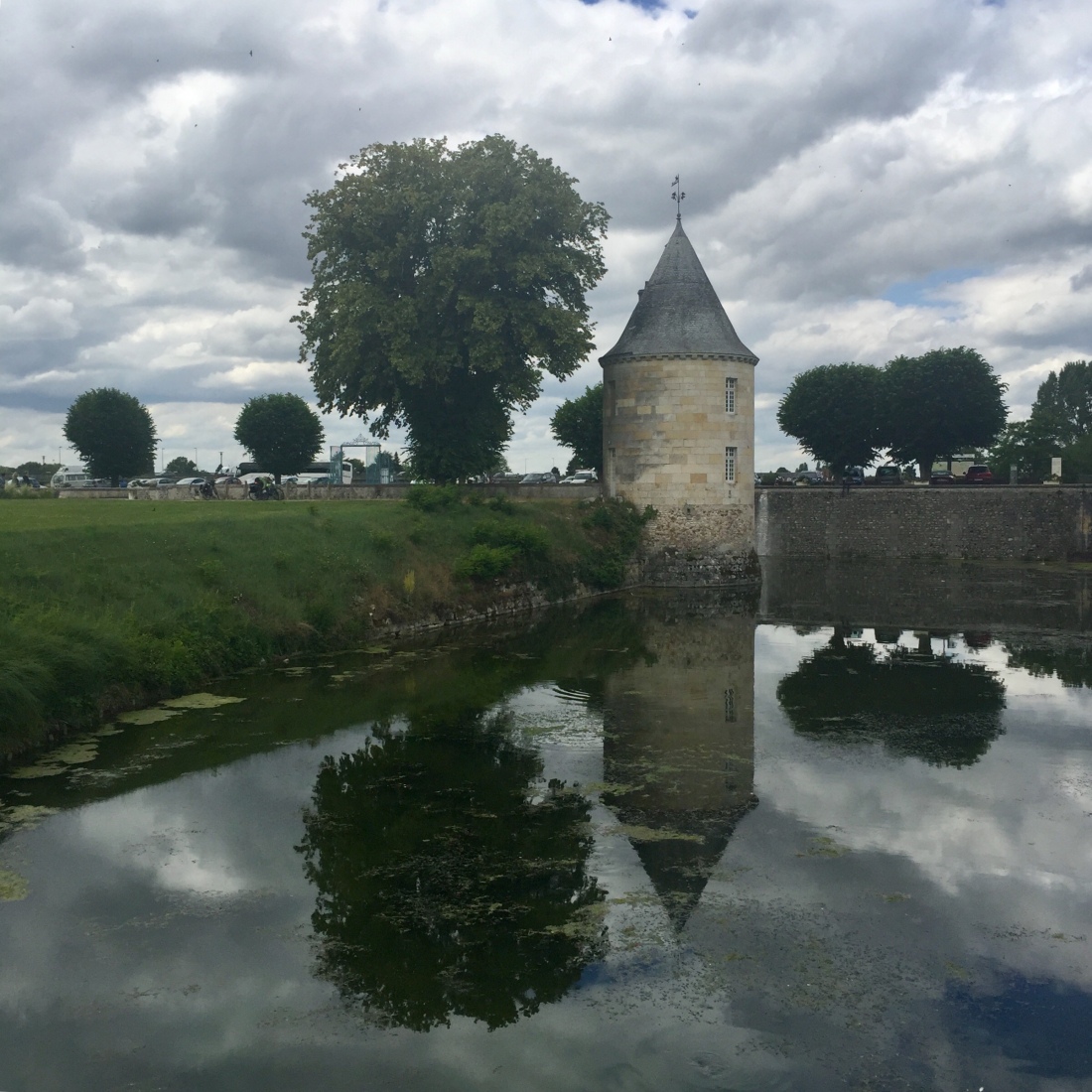
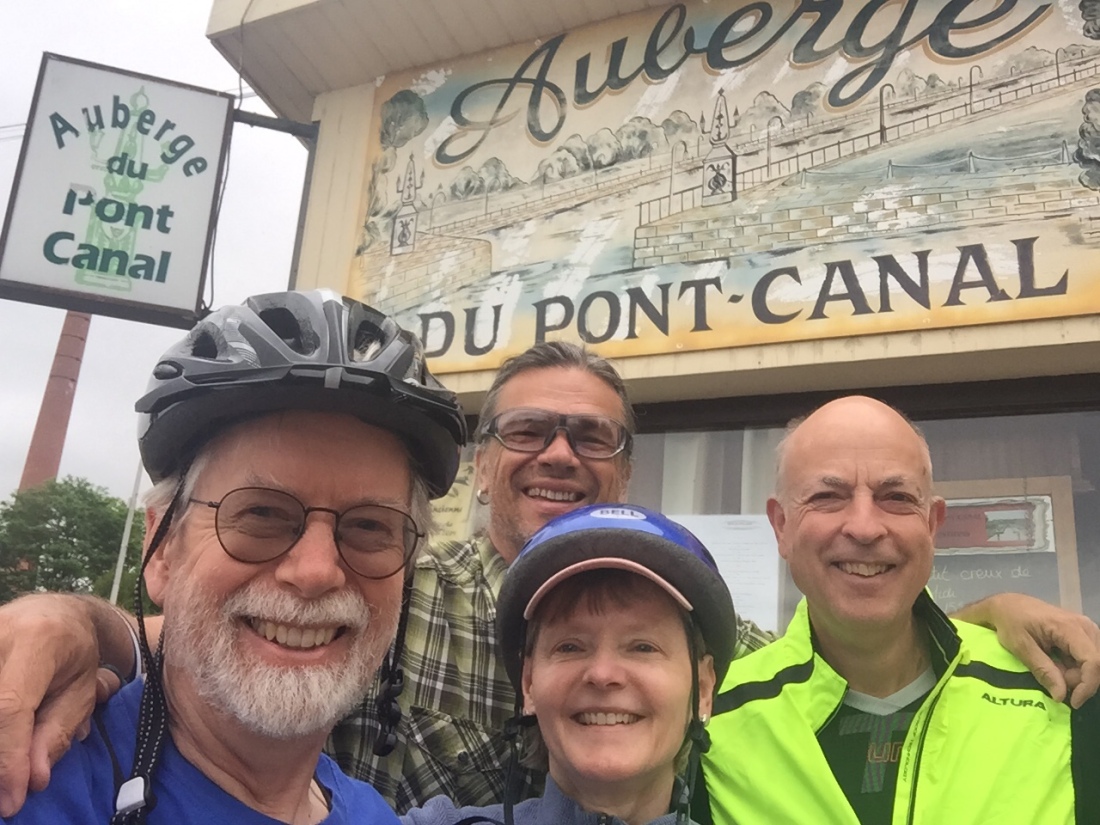





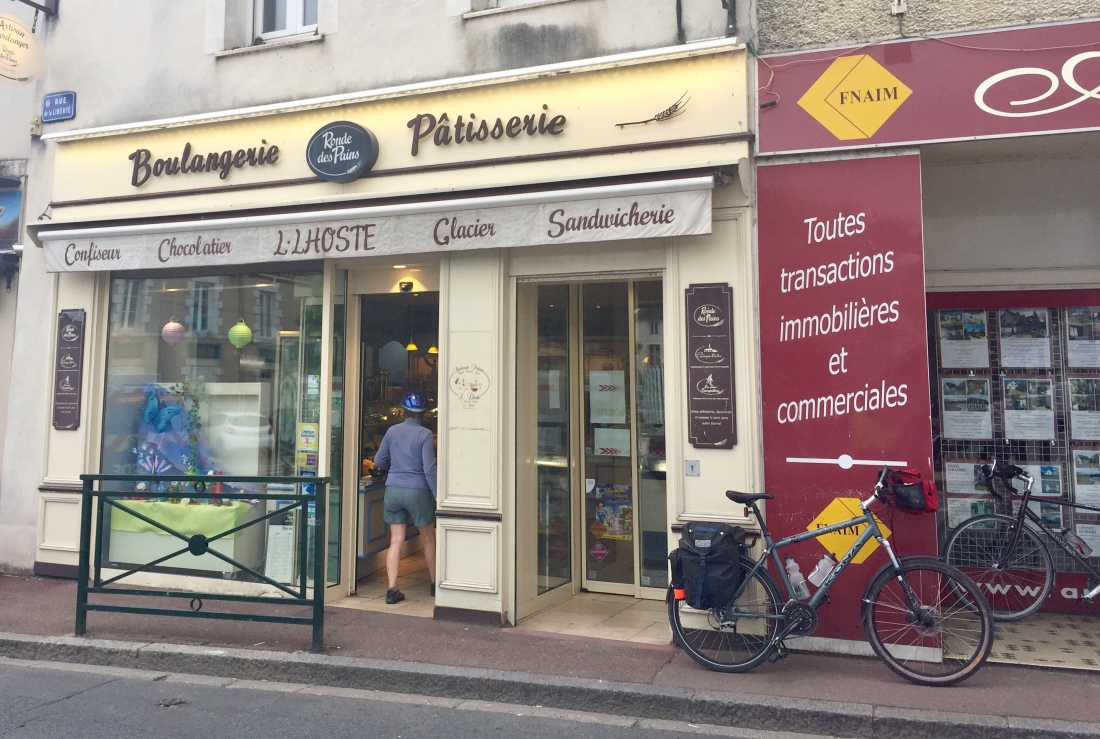




























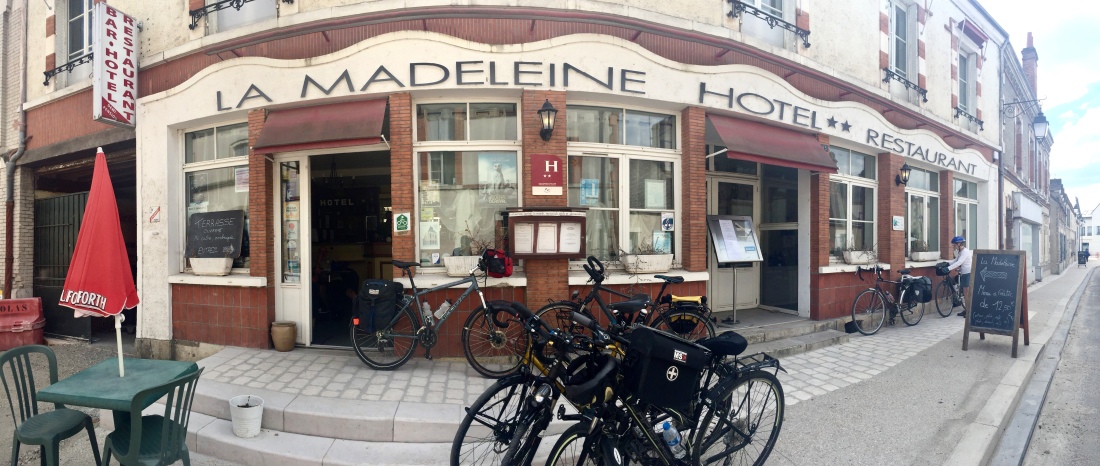




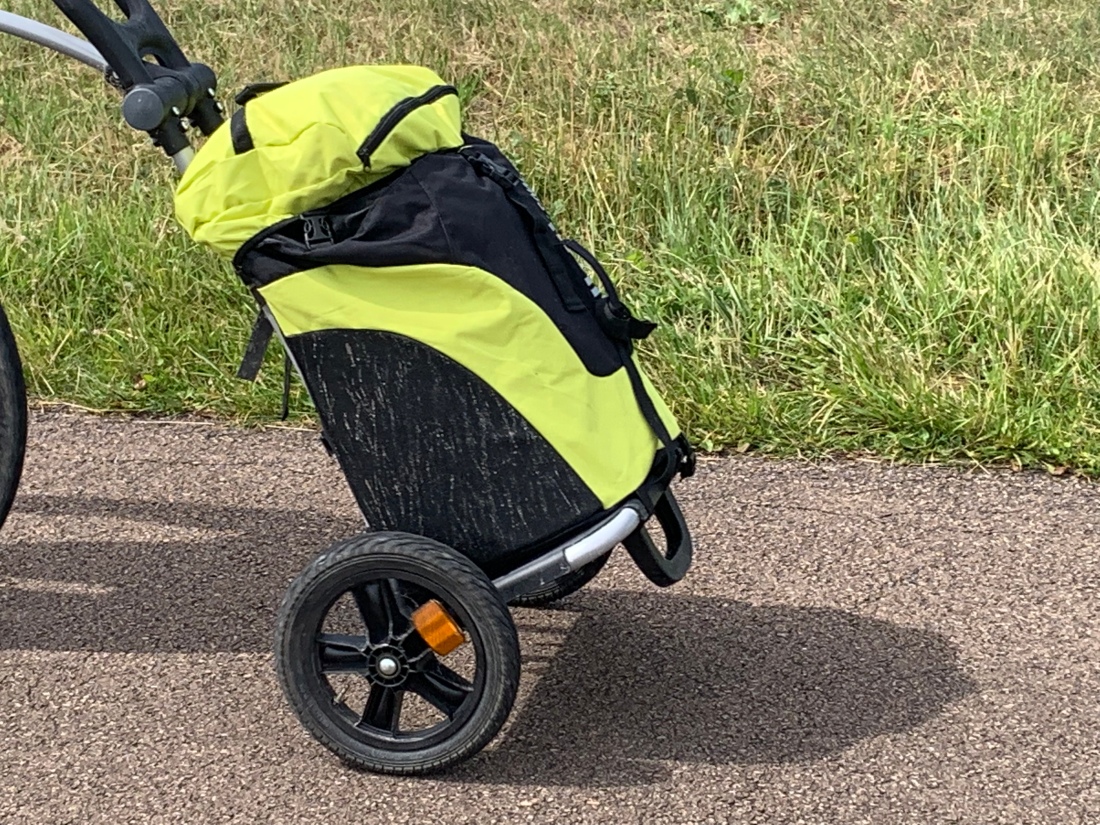 Carrying camping gear can also be achieved with a bike alone, as long as it is well packed. Below is an example of experienced touring cyclists from South Africa and New Zealand.
Carrying camping gear can also be achieved with a bike alone, as long as it is well packed. Below is an example of experienced touring cyclists from South Africa and New Zealand.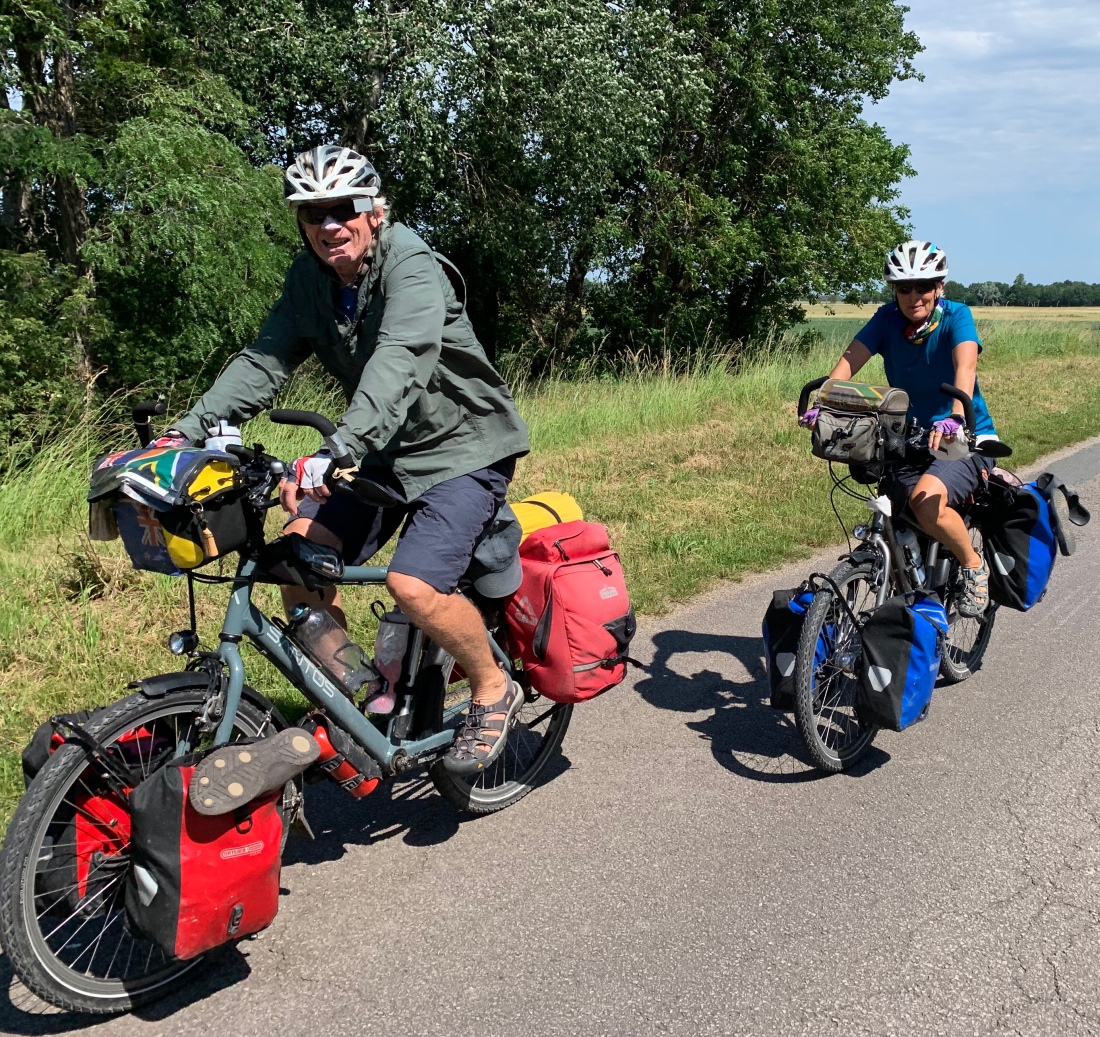 Lastly, a brief look at two eye-catching styles in men’s cycling wear. There is our Swiss friend Urs’s versatile rolled up trousers. There’s no chain grease on these trousers and they can easily rolled down for more formal events?
Lastly, a brief look at two eye-catching styles in men’s cycling wear. There is our Swiss friend Urs’s versatile rolled up trousers. There’s no chain grease on these trousers and they can easily rolled down for more formal events?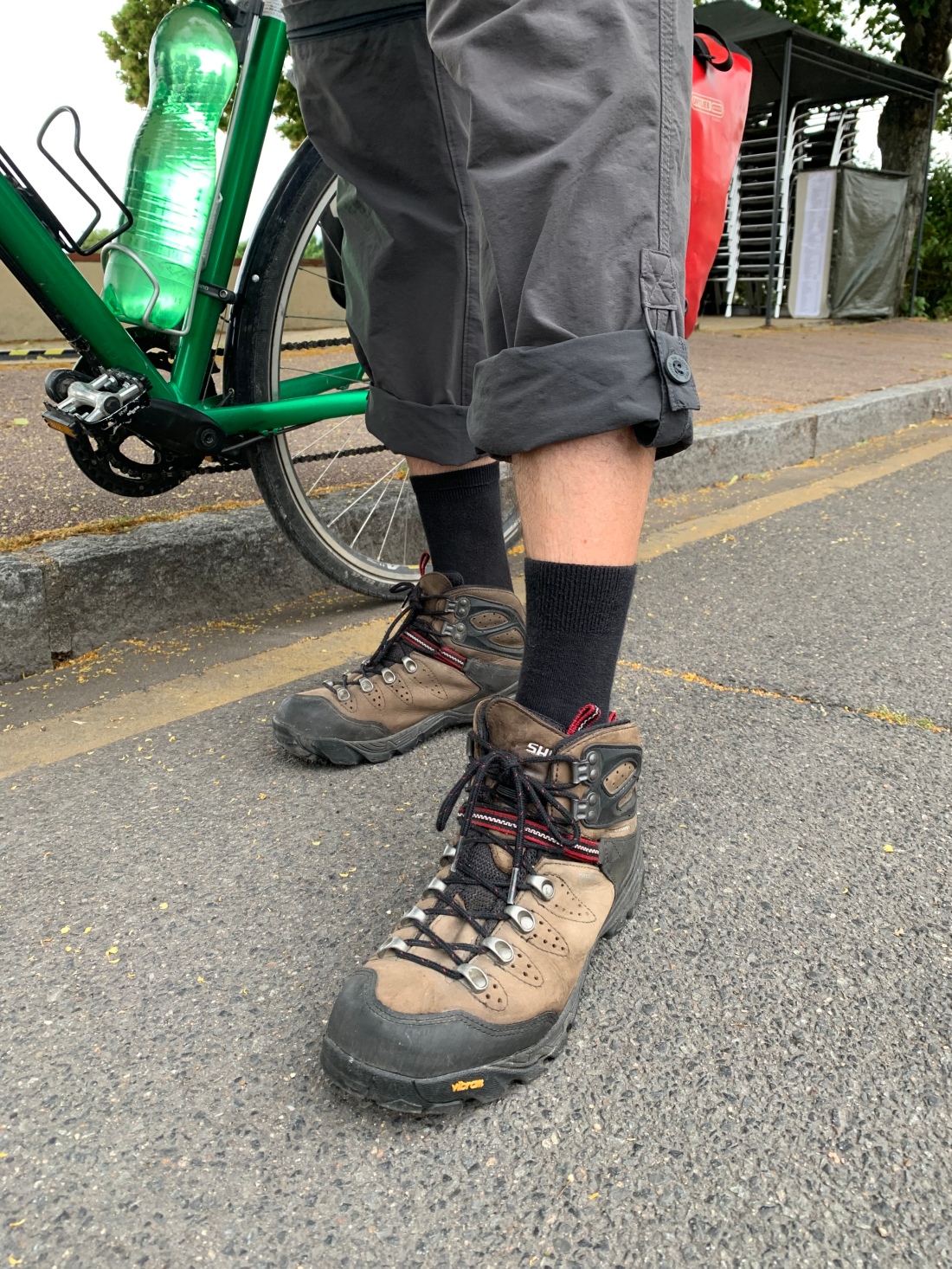 But there can only be one prize for the most elegant and practical cycling clothing, and that has to go to M’s ‘shower hat’ helmet, or as the French say…mon casque de douche (and the Finnish, minun suihku hattu kypärä)
But there can only be one prize for the most elegant and practical cycling clothing, and that has to go to M’s ‘shower hat’ helmet, or as the French say…mon casque de douche (and the Finnish, minun suihku hattu kypärä)

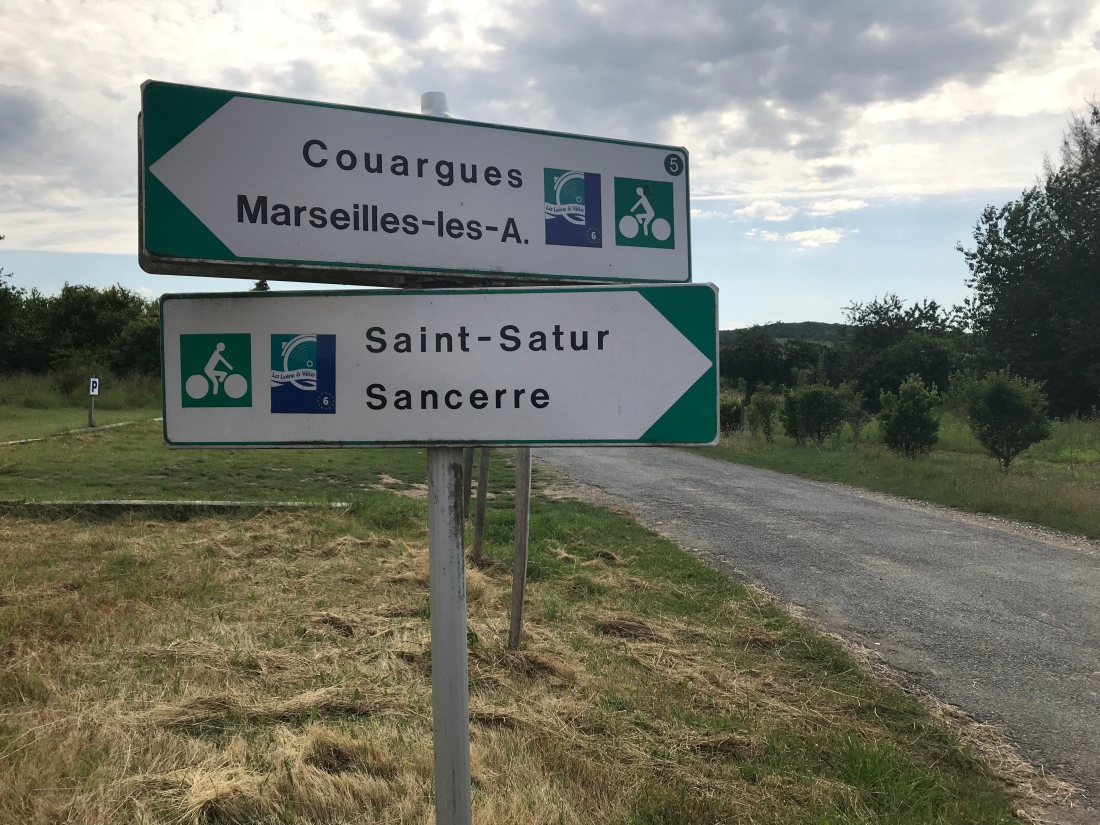 First of all, the route markers are very clear. There are multiple Eurovelo routes in Europe, so look for the number 6 and/or specific place destinations on your way.
First of all, the route markers are very clear. There are multiple Eurovelo routes in Europe, so look for the number 6 and/or specific place destinations on your way. On some roads, drivers are even told how much clearance to give cyclists. This we encountered as we approached Sancerre on Day 11.
On some roads, drivers are even told how much clearance to give cyclists. This we encountered as we approached Sancerre on Day 11. When on roads, motorists get lots of warning that they’re likely to encounter cyclists. (Be careful though when you’re entering and exiting larger towns when you need to be much more vigilant.)
When on roads, motorists get lots of warning that they’re likely to encounter cyclists. (Be careful though when you’re entering and exiting larger towns when you need to be much more vigilant.)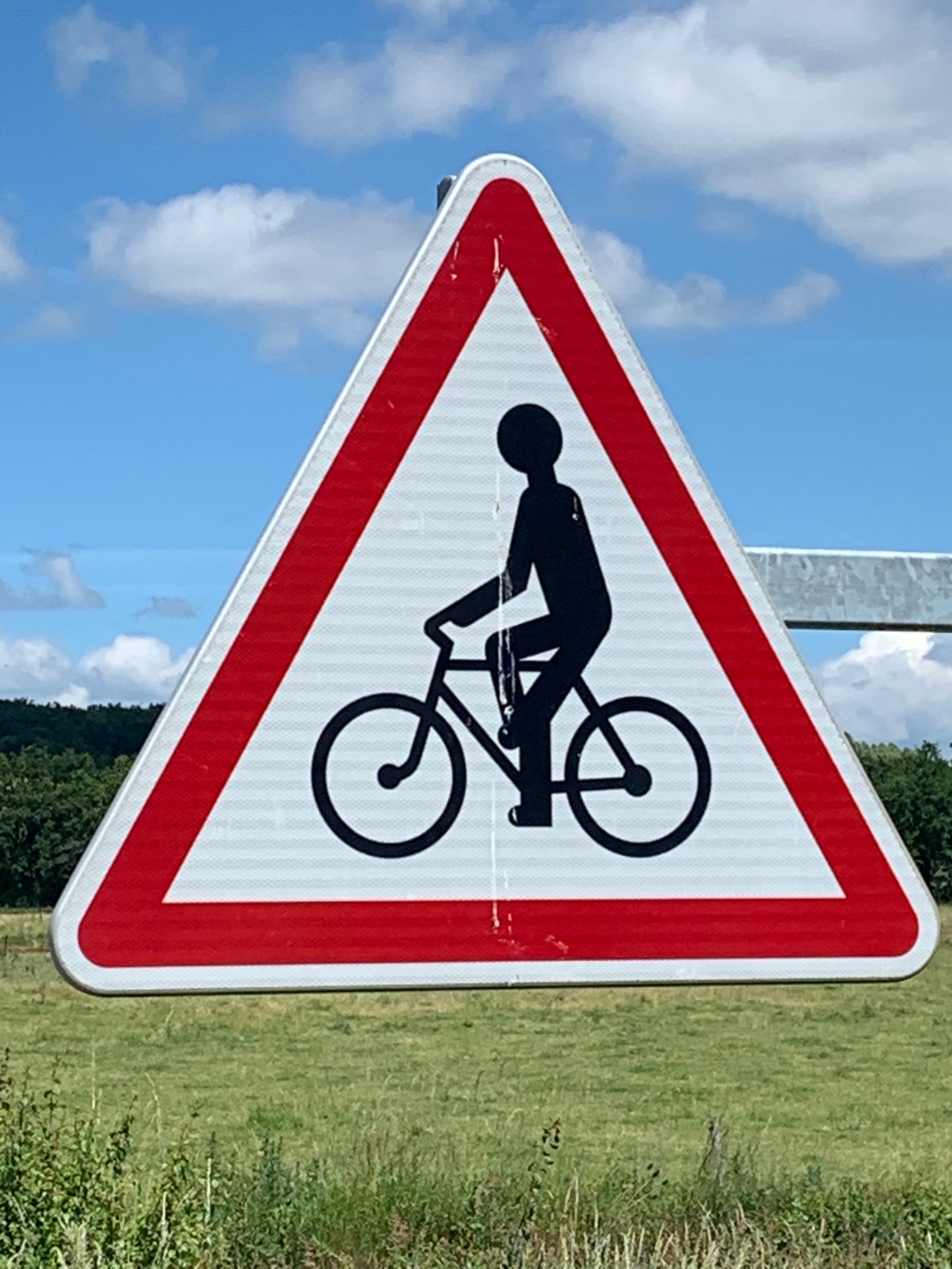 Warnings about road surfaces ahead are sometimes posted, such as this one about tree roots.
Warnings about road surfaces ahead are sometimes posted, such as this one about tree roots.


























 As I think was noted in an earlier post, the Pont-Canal was built to carry the waters of the Canal Lateral à la Loire over the Loire, connecting with the Canal de Briare. The decorative parts of the Pont-Canal are the work of Gustave Eiffel, with the overall design done by others; but Gustave seems to get credit for the whole thing.
As I think was noted in an earlier post, the Pont-Canal was built to carry the waters of the Canal Lateral à la Loire over the Loire, connecting with the Canal de Briare. The decorative parts of the Pont-Canal are the work of Gustave Eiffel, with the overall design done by others; but Gustave seems to get credit for the whole thing.

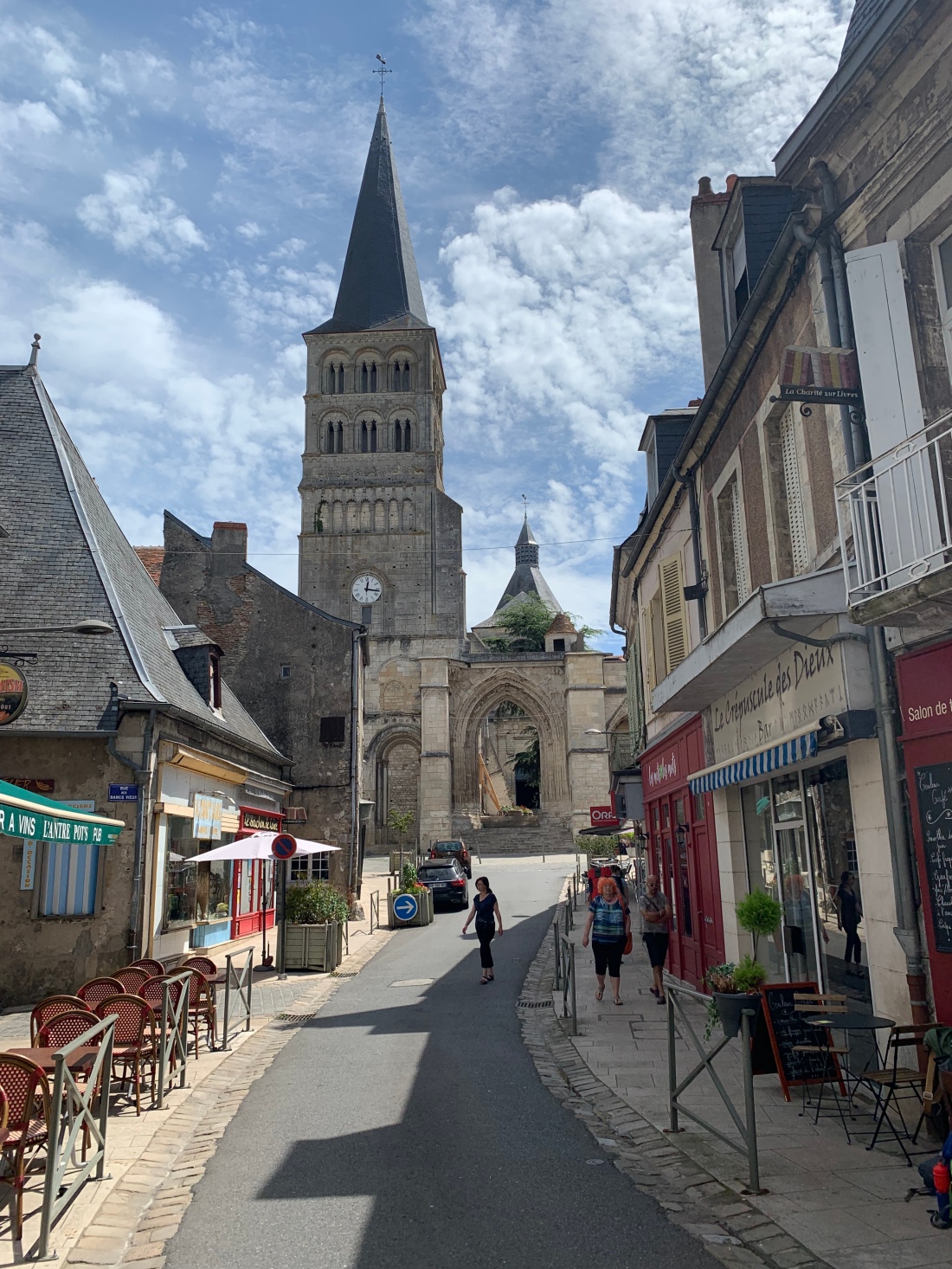













































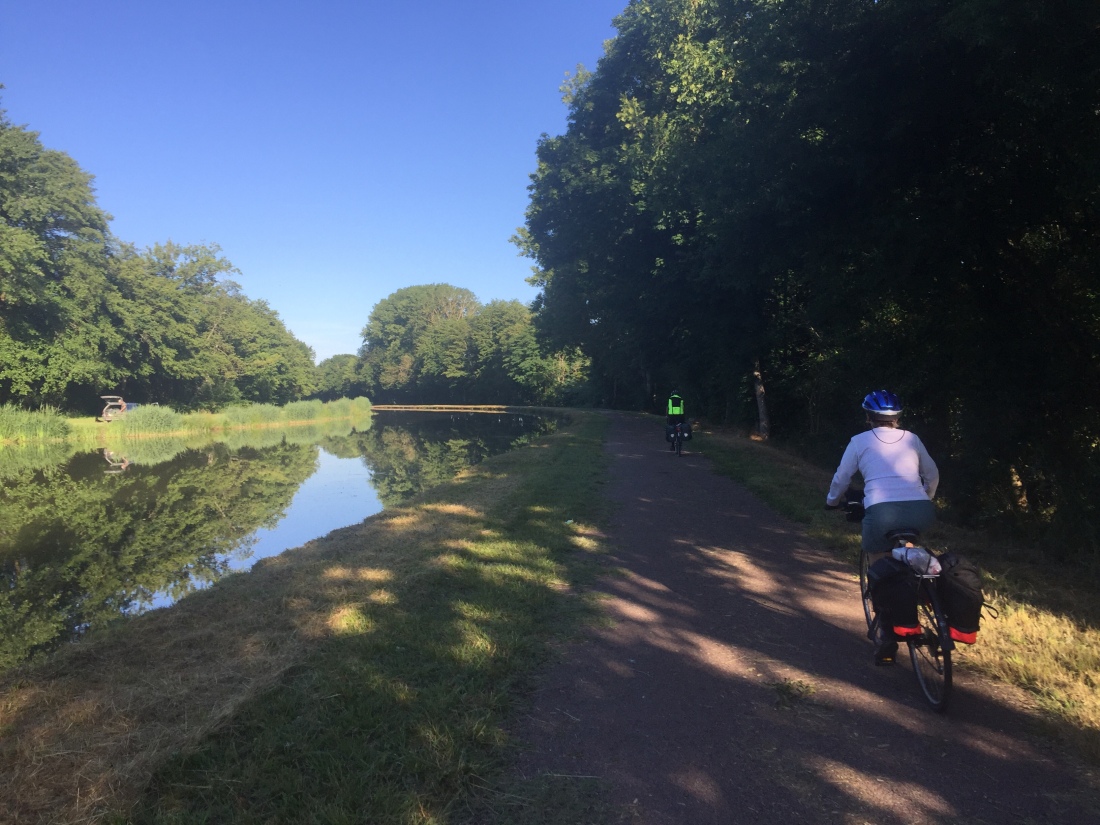
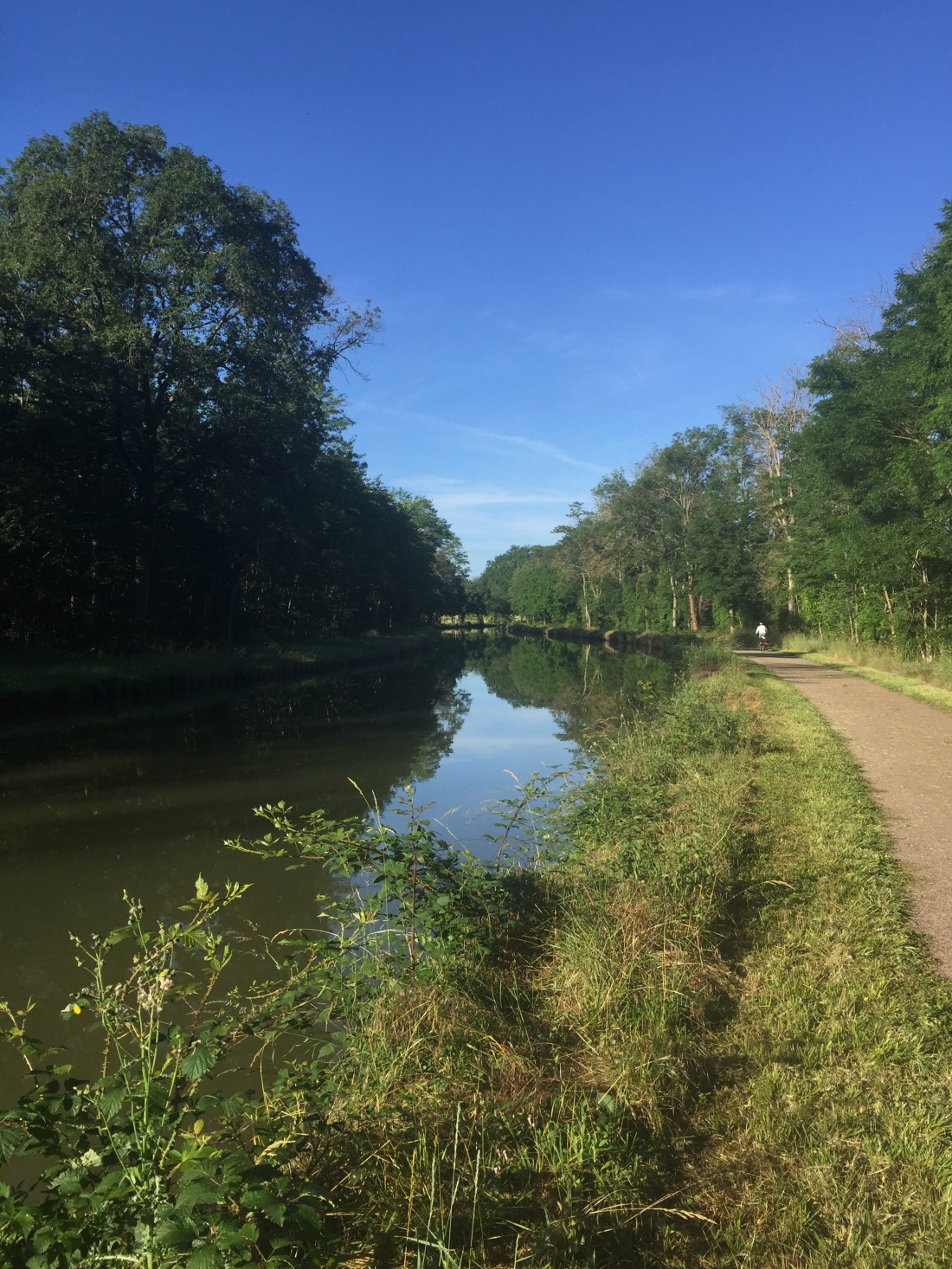 In an even more astonishing development, we realize that Day 10 has been our first no-pastry day! We’re not entirely sure how to explain this derangement: distractions, fatigue, lack of opportunity (most bakeries close on Monday; and we think Day 10 has been a Monday…) This lack of pastry may explain the trembling in A’s hands: withdrawal symptoms. We apologize to our followers, and vow to redouble our efforts; there is a growing backlog of requests which have come in through our Pastry Tasting Service hotline.
In an even more astonishing development, we realize that Day 10 has been our first no-pastry day! We’re not entirely sure how to explain this derangement: distractions, fatigue, lack of opportunity (most bakeries close on Monday; and we think Day 10 has been a Monday…) This lack of pastry may explain the trembling in A’s hands: withdrawal symptoms. We apologize to our followers, and vow to redouble our efforts; there is a growing backlog of requests which have come in through our Pastry Tasting Service hotline.











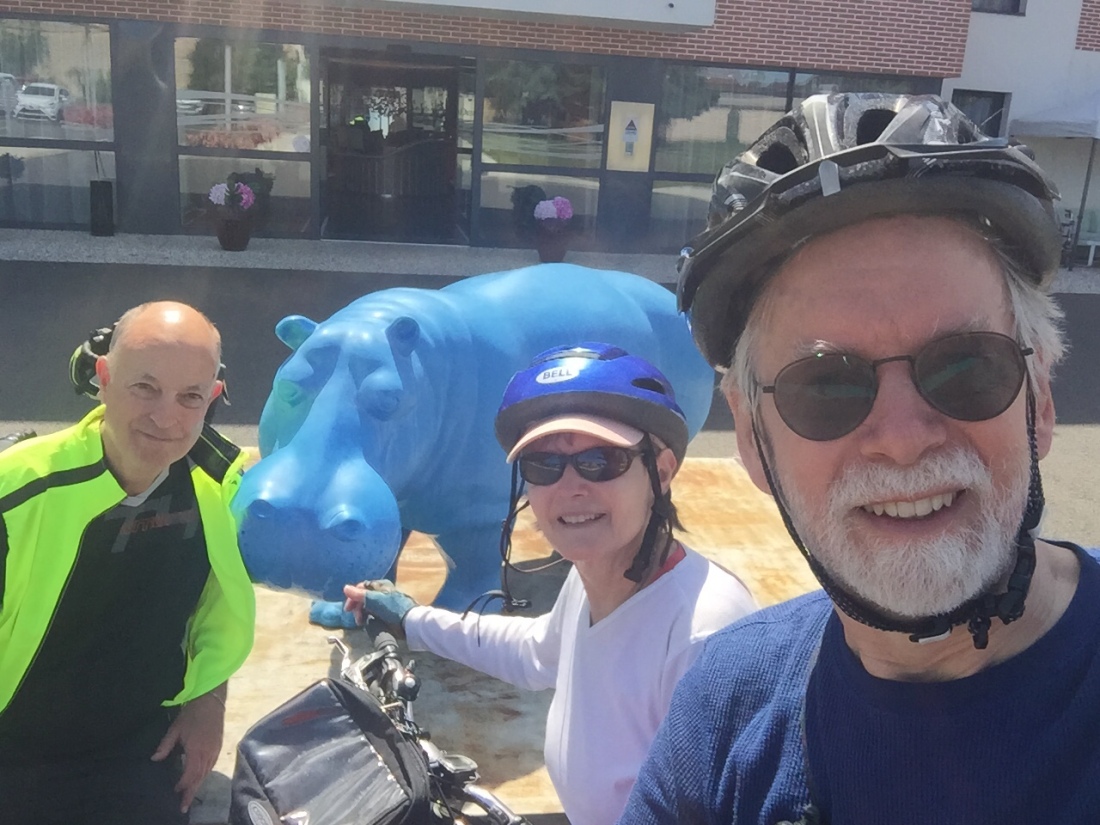













 Whenever we stop, J has been putting M and A to shame by stretching to keep her lower body, back and arms in good shape! So it is not hard to recognise J in the photograph below. Her early dancing lessons gave her flexibility to ride all day without an ache or pain. Lucky J!
Whenever we stop, J has been putting M and A to shame by stretching to keep her lower body, back and arms in good shape! So it is not hard to recognise J in the photograph below. Her early dancing lessons gave her flexibility to ride all day without an ache or pain. Lucky J! The final of the archive photos shows M looking up at the school clock, eager to get on his bike and go cycling. You’ll undoubtedly recognise the distinctive haircut.
The final of the archive photos shows M looking up at the school clock, eager to get on his bike and go cycling. You’ll undoubtedly recognise the distinctive haircut. Below shows M and J deciding which photos from their extensive archive to share with our loyal readers.
Below shows M and J deciding which photos from their extensive archive to share with our loyal readers.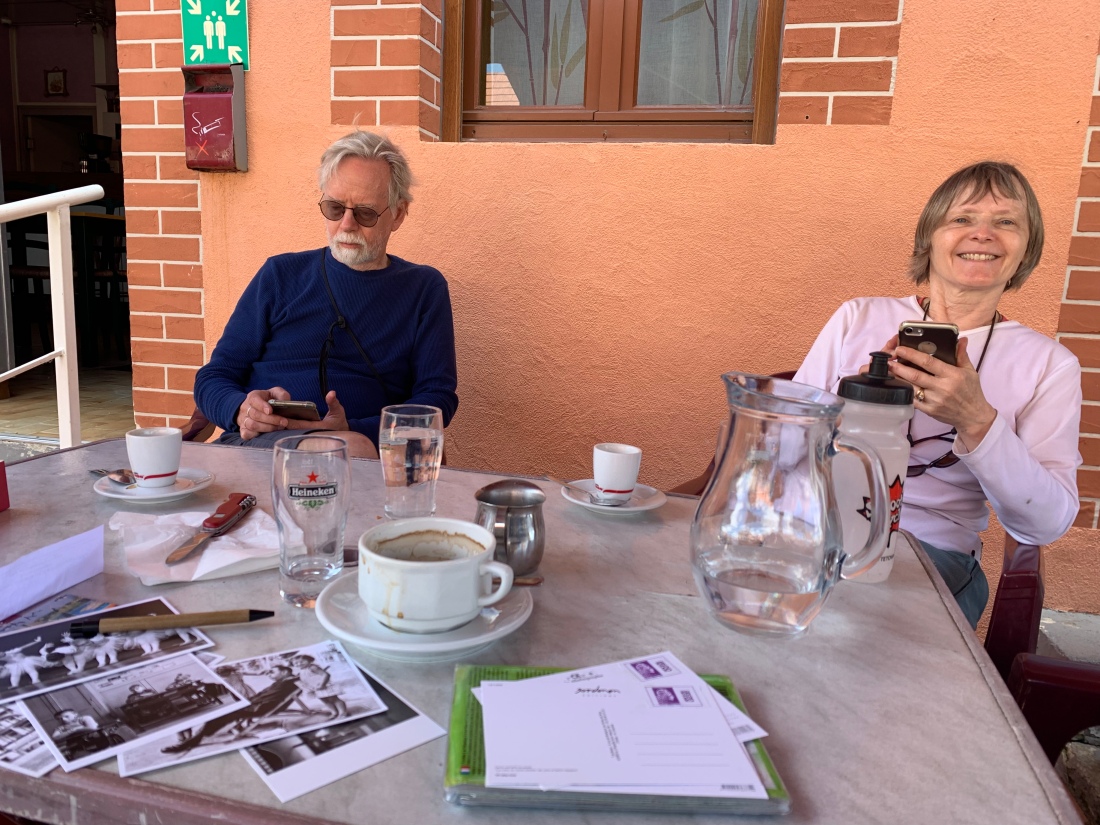











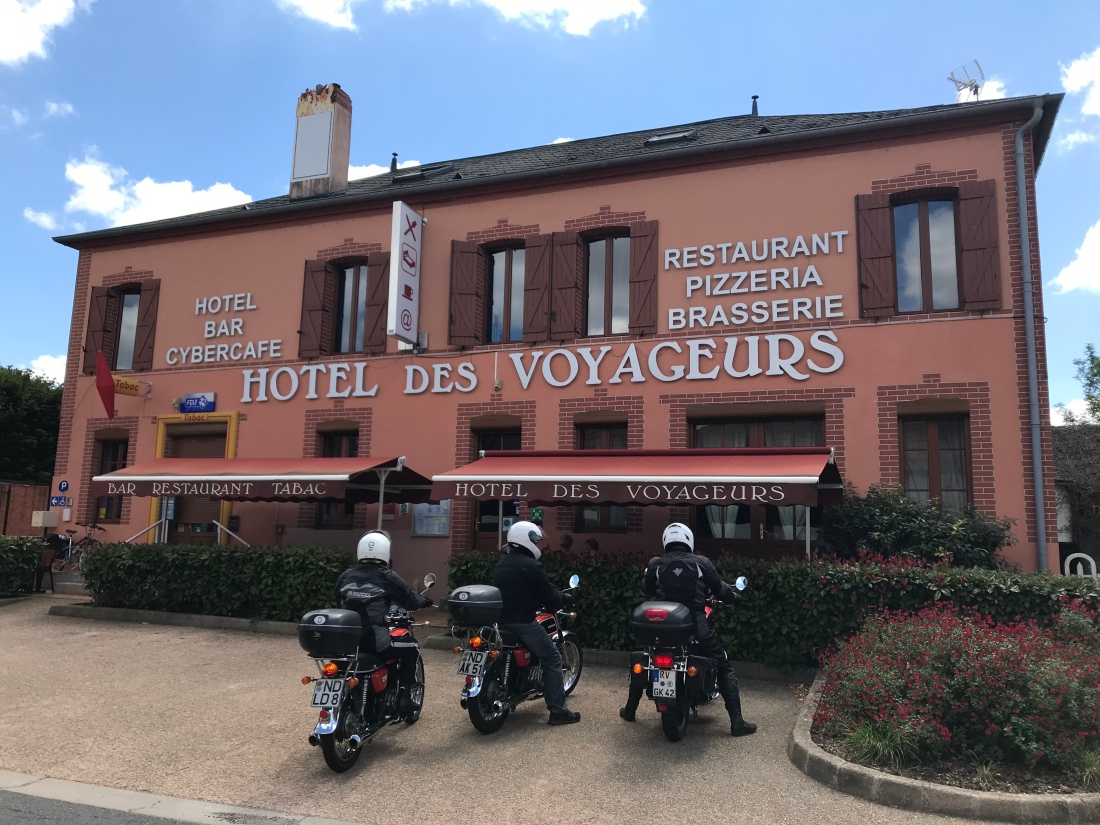 We find a suitable one, the Hotel des Voyageurs, in Cronat, the next village down the road. It has a shaded terrace; it faces onto a quiet square; it has wifi—and there’s a bakery nearby. The bakery’s selection of pastries is meager, but attractive; it being a Sunday, we reverently select a Religieuse (which loyal Downhill readers will recall being described as “two choux pastry cases, one larger than the other, filled with crème pâtissière, most commonly chocolate or mocha”). Later, in what might be an instance of divine intervention, we receive a request from Finola, a faithful Downhill follower, who has taken advantage of our new French Pastry Tasting Service, asking us to sample a Religieuse on her behalf; we live to serve.
We find a suitable one, the Hotel des Voyageurs, in Cronat, the next village down the road. It has a shaded terrace; it faces onto a quiet square; it has wifi—and there’s a bakery nearby. The bakery’s selection of pastries is meager, but attractive; it being a Sunday, we reverently select a Religieuse (which loyal Downhill readers will recall being described as “two choux pastry cases, one larger than the other, filled with crème pâtissière, most commonly chocolate or mocha”). Later, in what might be an instance of divine intervention, we receive a request from Finola, a faithful Downhill follower, who has taken advantage of our new French Pastry Tasting Service, asking us to sample a Religieuse on her behalf; we live to serve.


 The route rejoins the Loire at Port Thareau, where we find a perfect picnic and/or swimming spot. In Charrin we investigate the local church, and pay our respects to the widow Pioux and other members of her family.
The route rejoins the Loire at Port Thareau, where we find a perfect picnic and/or swimming spot. In Charrin we investigate the local church, and pay our respects to the widow Pioux and other members of her family.



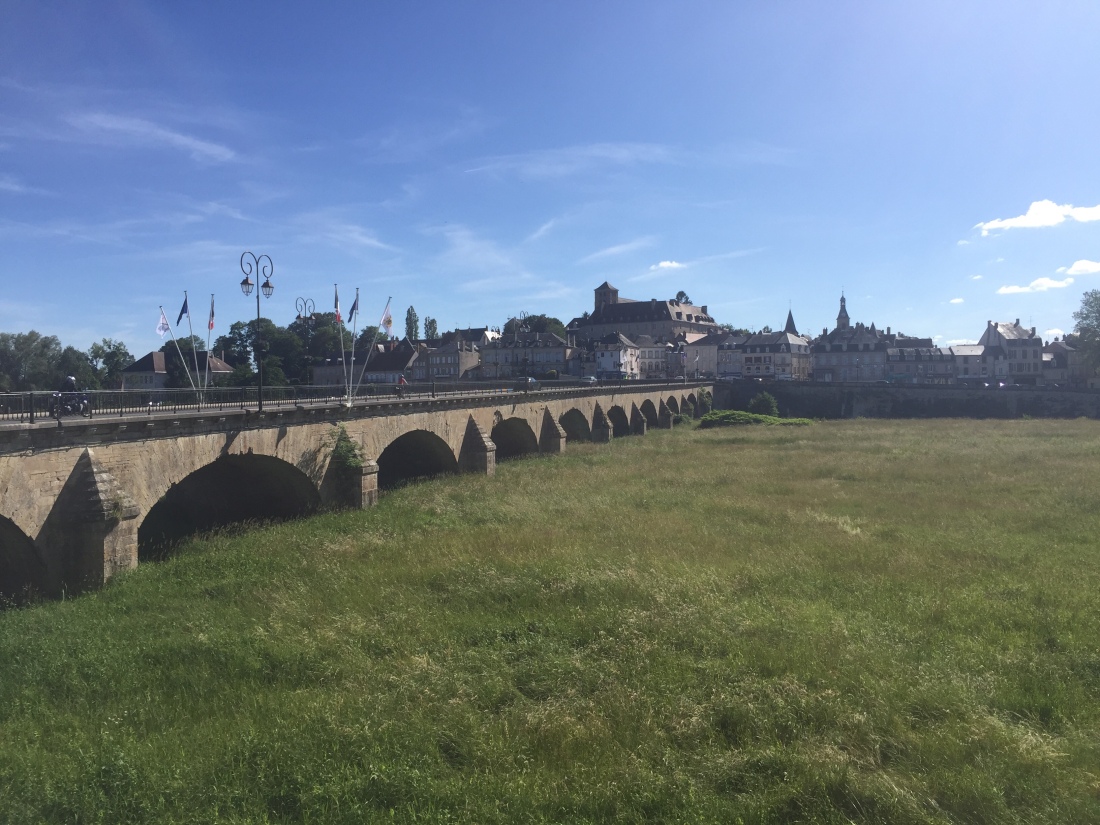 We’ve got two rooms at the Hotel Port Decize, just beyond the old town centre, in a new complex that caters to boaters as well as cycle tourists. Among the other cyclists staying: a group of three Americans, who are heading east, riding what might be described as novelty bicycles, propelled by a kind of elliptical mechanism: they ride them standing upright, pedaling in long, looping strides.
We’ve got two rooms at the Hotel Port Decize, just beyond the old town centre, in a new complex that caters to boaters as well as cycle tourists. Among the other cyclists staying: a group of three Americans, who are heading east, riding what might be described as novelty bicycles, propelled by a kind of elliptical mechanism: they ride them standing upright, pedaling in long, looping strides.










